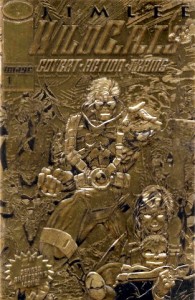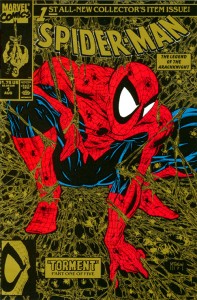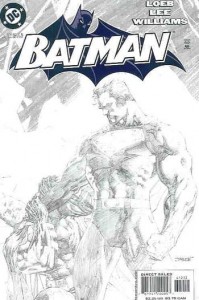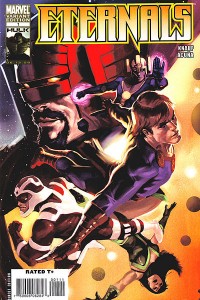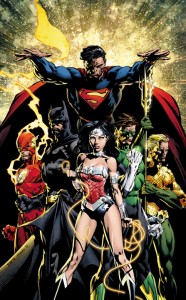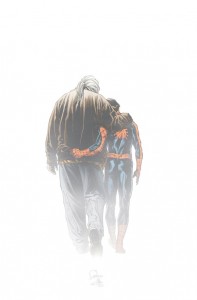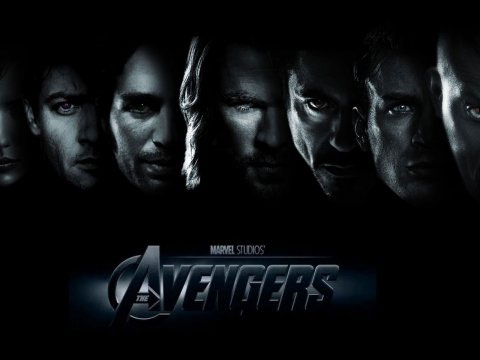Welcome to Retailer Q, spinning 52Q’s format at top Canadian comic retailers. Comic Book Daily asks the question and our retail friends give their perspective.
[box type=question]It feels like the 90s are back again with the major publishers releasing variant covers for a large portion of their books; at least the multiple covers aren’t returning (I hope). Now DC has announced 1:200 variants as part of their relaunch.
Is there a market for variants, and if so how long does it last? Do variants have any legs as a back issue collectible?[/box]
[box type=shadow]Jay Bardyla had one clever thought in his life, to open Happy Harbor Comics, in Edmonton Alberta. The rest of his thoughts he hopes to get an official pardon for.[/box]
There is always at least 1 buyer and in our case, often about 3. The decision is usually whether or not I want to sit on all the extra copies. But since we do a lot of work with schools and libraries, they always make for decent giveaways.
[box type=shadow]Marc Sims, owner and general manager of Big B Comics in Hamilton Ontario. Our life is comics and life is good.[/box]
I have pre-sold 7 1:200 variants for the new DC already. This is going to allow me to get a lot of copies of the new books into my shop so I can more accurately find the ceiling on them. I am totally ok with that.
I ignore a lot of the 1 in 10, 1 in 25, etc variants that Marvel especially churns out. Those I can’t really price up and sell with any regularity and if I put them out at cover price, they usually just subtract a sale of the regular cover for me (ie few people will buy the regular and the variant even when both are priced at cover). Just off the top of my head I would estimate I order in maybe 15% of the variants offered, and I qualify for 90% of them.
I understand that if you really want to do well with variants pre-selling them on eBay is the way to go, but I just don’t have the time or energy to do that anymore.
As far as the aftermarket goes, I think we all know it’s not pretty except for on the ultra-limited ones (1 in 200, 1 in 250, the old DC RRPs). To be honest I don’t track it too much though. I just know that if I haven’t sold a variant in a certain timeframe I mark it down until it sells, like any other stale merchandise in my store. For certain variants that stale period starts after about 7 days which is pretty fast of course but on others, like any ASM variant, I can sell them at full price for quite a while.
[box type=shadow]Christopher Butcher is the manager of The Beguiling Books & Art in Toronto, Canada. In addition, is the Co-Founder of The Toronto Comic Arts Festival, and blogs about the comics industry.[/box]
Simply, variant covers are a pox on the industry. They encourage retailers to order greater quantities of books than they otherwise think they can sell, for a lottery ticket style chance at turning a much bigger profit than expected. That sounds aggressive, but ultimately I think the mainstream superhero pubs have shown that they’re less interested in overall industry health than their own bottom lines, and their sell-in is muuuuuch more important than their sell-through. Given those factors, it’s perfectly reasonable to assume they’d do everything in their power to get retailers to increase orders even past the point of sustainability.
I know every retailer knows this, but I want to make it clear for the fans and those concerned about the industry; I think everyone knows Marvel’s “line-wide” variants, right? Where all of their core titles in a given month will have the same themed variant, like “Heroic Age” variants, or “Women of Marvel” or “Superhero Squad” or “Monkey Covers” or “Tron” or “Hollywood” or whatever. Themed variants, usually 30 titles in a month get them. In 2009, those line-wide variants could be ordered in a 1:10 ratio to the regular comics–for every 10 of the regular, you could get one of the ‘rare’ cover. In 2010 that ratio went up to 1:15. Last month’s “I Am Captain America” variants were all 1:20. This is all set against 3 years of constantly falling sales, and falling orders, but raising the bar to get incentives, breaks, and sales tools.
The worst of it is, in September? DC is relaunching their entire line and asking for a huge investment from retailers. Rather than recognize this, and maybe work for greater overall industry health, Marvel is trying desperately to maintain their own bottom line and doing two different levels of line wide variants, 1:26 and 1:52. That 1:52 number, besides being obscenely high, is also clearly a shot at their competition. It’s just gross behaviour from an industry leader, it is self-interest to the point of… well to the point of the industry we’re at, less than 2,000 comic book stores and 1 dedicated comics distributor. It’s 90s thinking in more ways than one.
And, yes, ultimately the onus is on retailers to make intelligent and sustainable purchasing decisions, to weigh their lottery ticket investment against keeping the lights on this month. But as an industry-wide practice that 90+ percent of direct market publishers are participating in, encouraging greater sell-in regardless of sell-through, it’s gross. Individual variants aren’t a problem, 1:200 variants aren’t a problem, line-wide variants as a concept aren’t even a problem, but the underlying mentality of aggressively encouraging unsustainable and destructive ordering practices are a huge problem.
Jay: As silly as 1:52 variants are, I don’t find them nearly as offensive as the “Destroy Flashpoint comics and get 1 Marvel variant” promotion. That’s just greasy, childish and unhelpful to the industry.
With variants, Chris, do you subscribe to the (I believe it’s) Brian Hibbs theory of not ordering any even if a customer requests it?
Christopher: No, I think that’s crazy. If a customer orders something, and is willing to pay for it (at whatever cost is reasonable to me), then I order it. We can never guarantee variants to our customers, but if someone came in and said “I will buy 200 copies of Action Comics #1 to get the 1:200 variant” then I would gladly accept their money.
No offence intended to Hibbs, of course, if that’s an accurate description of his position.
Jay: He drew a line with variants and he stands by it which I give him props for. I’ve thought about it but I try to use all the extra books for other causes.
[box type=shadow]Calum Johnston, owner of Strange Adventures comic shop chain. Trying to make the world a safer place for comix.[/box]
Not much market for them locally, at least not at anything more than cover price. I still say publishers should put the best cover on the comic and that would help improve sales rather than this 4 to 1, 10 to 1 silliness. I have found what little demand there is to be very short-lived.
Nope (to back issue market); or at least, none that I have seen.
[box type=shadow]Bruno Andreacchi, B.A.’s Comics in London Ontario. Slight spine damage otherwise I’m fine to very fine.[/box]
While I only dislike variants generally, I’ve recently come to despise how they’ve palpably devolved lately to the point of absurd self-caricature. They’re just everywhere! 200 copies. 300 copies. It’s become beyond ridiculous.
Remember order 10 and that included a variant? Now it’s order 10 and you qualify to order a variant. I now label those as 1 in 11. What continues to mystify me (because I thought this had been dealt with) is multiple covers on one line order. Ordering 5 is supposed to get you 4 of A and 1 of B. Instead you get 5 and 0, and a fast call to your CSR yields a “Cover B is out of stock. ” Wha-?! Or 4 covers in an equal ratio but you only receive 2 covers and your CSR informs you that the two missing covers can’t be guaranteed. (Once, I tried “OK, send me four then” and I still didn’t receive the 2 that I was originally shorted. Never again.)
Damage control becomes the order of the day when a customer/collector gets denied the version that he wanted, and I ordered, and the publisher or distributor didn’t. and can’t, deliver. Now we’re seeing what Godzilla has wrought. For only $2000, you, too, can have your face on the cover of Spider-Man. Vanity publishing lives.
Today, ICv2 reported that “Driven by press coverage…Ultimate Comics Spider-Man #160 [sold] over 159,000 copies to comic stores…”. First of all… no. I didn’t order more because of any press coverage. I ordered more because I knew that some people would want -*sigh*- “one to read and one to keep mint in the bag”. You know, I would rather just sell good books without having to always “do the math”. Yeah, sometimes I do go for the variant, when it’s expedient, but I hate the fact that my anecdotal moments of weakness translate into erroneous statistics. As a result, I think the monthly sales charts are laughably useless. Meanwhile, publishers continue to trip over themselves to “score” in the top ten and in pie charts.
There are plenty of variants that I don’t qualify for that a few Variant Hunters want. I tell them that if they can wait six months, Marvel will have a sale and I can then sell them for cover price. It happened with the Wolverine Art covers and it’ll happen with the Thor Hollywood covers.
We’ve always tried to cultivate readers first and foremost, and collectibility second, but not artificial collectibility. In the long run, it’s just not worth it.
[box type=shadow]Paul Stock, Librairie Astro in Montreal Quebec.[/box]
As much as variants annoy me when preparing the monthly order (and they do- enormously), I’ve come to accept them as just another aspect of the hobby. There are people that collect them, plain and simple, and I like to satisfy people’s wants. Chase covers (as I call them) seem to be a fad amongst publishers, but I certainly don’t see them as such amongst consumers: Out of our 650-odd “reserve”/subscriber/”pull” customers, there’s only a half dozen or so who (only sometimes) care about any particular one, and none of those half-dozen “blanket their wants- they’re always quite specific about which cover suits their fancy, moving from title to title, from artist to artist as the mood suits them. I don’t think any of them are completists, driven to get that expensive chase variant to ensure there’s no holes in their sets. Once upon a time, “Shi” was a popular character, and despite my dislike of Billy Tucci’s ways, I ordered Shi to satisfy my customers. That popularity faded, as everything’s popularity does. No great loss to us or the world of comics in general when Shi disappeared, just as it will be no great loss when 1/10-15-100-1/1000 covers disappear. Fashions change and we all move on.
And yes, I sort of snicker when I see 1/200 covers offered for some doomed to obscurity title, and I think “Oh well, writing up the bumf gave some feckless publisher’s drone something to do. Something meaningless, but something, anyways. So Disney or Warner throws a few more bucks into the industry by paying someone to write the solicitation drivel- every dollar coming in, on whatever level, helps keep us all going, even if our interest is nil.
And the variants themselves? As long as people enjoy getting them, keep ’em coming. I don’t think anyone except dealers are actually investing in them, so there’s no harm in their existence.
[box type=shadow]Jennifer Haines, The Dragon in Guelph Ontario. MA, B.Ed. Full-time teacher and comic store owner? Some say crazy… I say just crazy enough to work![/box]
For us, there isn’t a market for variants. We have one or two customers who want multiple covers when they ship equal ratio, but beyond that, none of our customers seem to care about the cover art. It’s all about the story or interior art. We used to bring in 10:1 variants and sell them for regular price. We were selling them, but only if the cover artist was in demand. Then I decided to try selling them at $10 each. That worked for a while, but the one or two customers who cared, stopped caring. Now, it’s extremely rare that someone requests a specialty variant.
Variant covers have never been something to make me up my orders to meet the requirement. I’m going to order what I’m going to order, based on what I know I can sell. I’ll admit I did order low number variants for the new DC 52, but I won’t likely order them for issues 2 and up, unless people ask. The first issue has a better chance of selling a variant than any others.
I think the only people who can really make a go at variant back issues are stores that build up a reputation for it, and go deep on it, and maybe CGC them. I’m sure there’s a market out there for these items, but it just doesn’t exist in my city. With most comic trends, it all depends on where you are.
[box type=shadow]John Tinkess, manager of Another Dimension in Calgary.[/box]
When variants first started reappearing about five(?) years ago, the market for them was very strong but as with most things in our industry as soon as there is a perceived demand, publishers flood the market until it’s eventually destroyed. In the past, we were able to price variants high enough to cover their “cost” (ie. a 1:10 variant could be priced at around the wholesale cost of 10 copies of the regular book) which effectively allowed us to order higher quantities of certain books knowing that variant sales would cover our costs and allow us to promote additional sales on the regular series. Unfortunately, what started out as an occasional special event turned commonplace as we started receiving dozens and dozens of variants every week and we now have a hard time selling anything but the rarer variants for more than cover price.
The variant market is also very volatile and extremely short. If it doesn’t sell in the first week, it probably won’t sell at all as most variant buyers have a greater sense of urgency and will hit the internet if they can’t find what they’re looking for immediately. Some publishers also have a tendency to release additional copies into the market at a later date which will usually drive down the price, especially on higher end variants.
We have already had a number of inquiries regarding the DC 1:200 variants but without firm pre-order commitments, they’ll have little effect on our ordering. We might round up our numbers slightly if we’re close to the next plateau but variant sales are just too inconsistent to invest that much money in a maybe. Plus, I don’t see the market supporting the $250-$350 price necessary just to break even on an extra 1:200 variant.
DC has announced a number of initiatives to support the relaunch with returnability and/or extra discounts applying to most of their titles and I think those are the programs that will be the most beneficial to the vast majority of stores. Considering the current state of the industry, I view the 1:200 variants as more of a reward for large stores that would qualify anyway than as incentives for extra sales.

